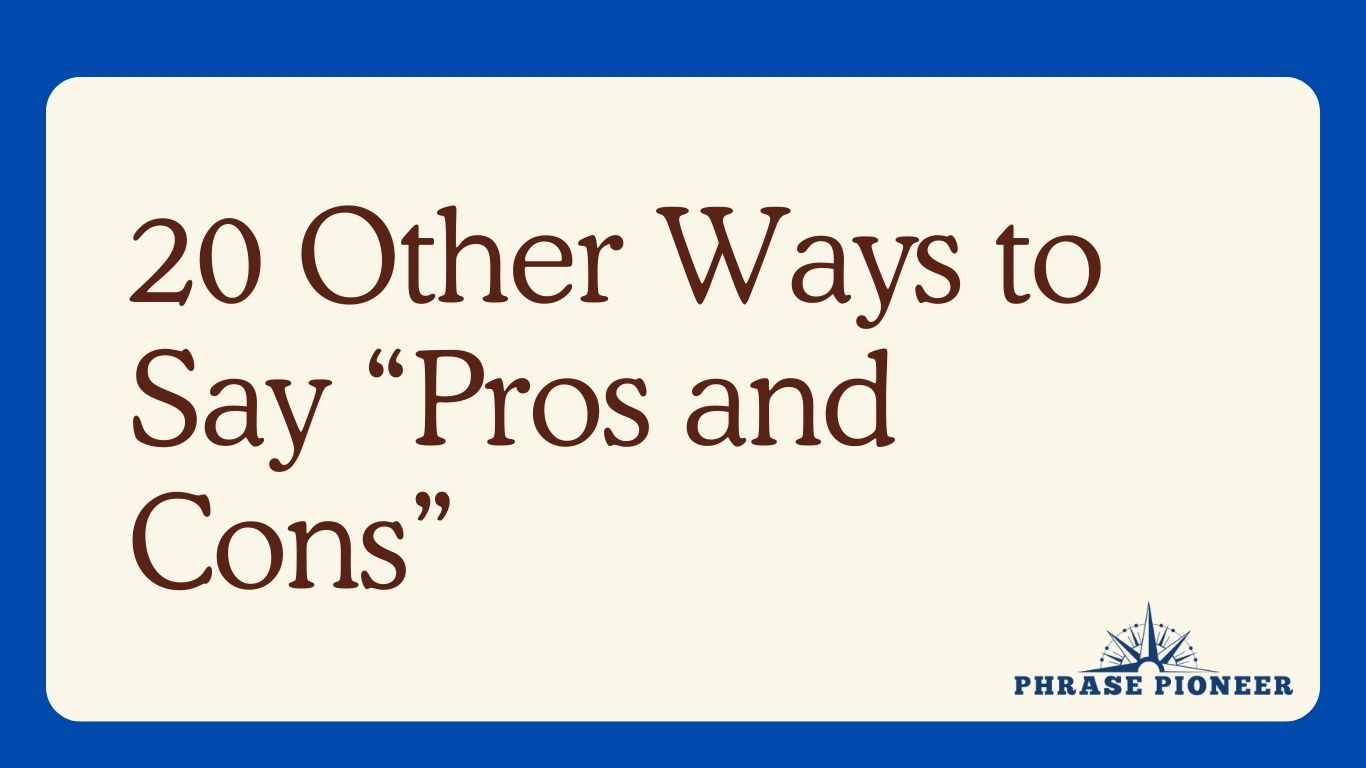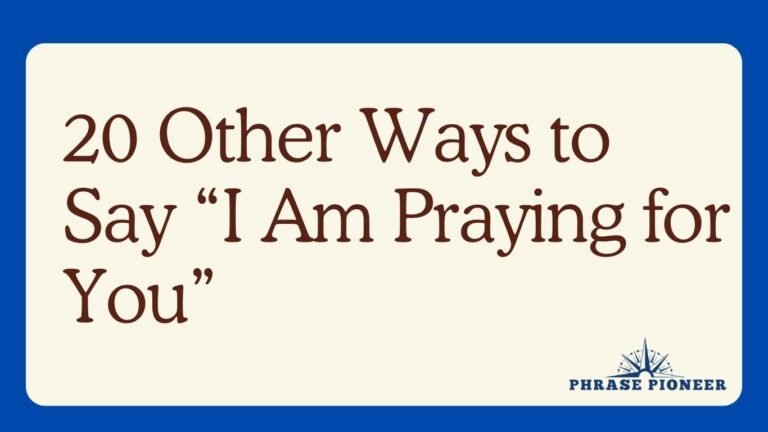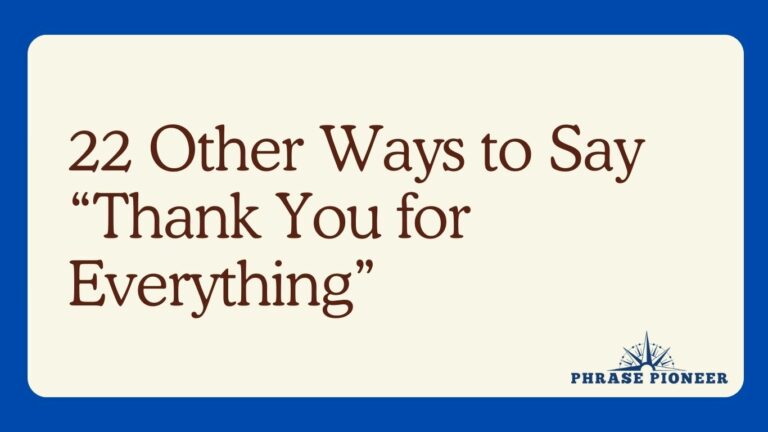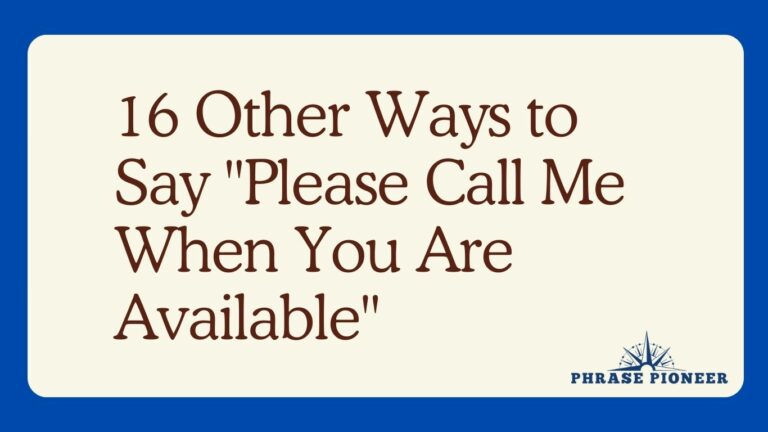20 Other Ways to Say “Pros and Cons”
When evaluating a decision or argument, weighing the “pros and cons” refers to considering the positive and negative aspects respectively. However, in certain contexts or for stylistic variation, alternative phrasings can be very useful. Here are twenty other ways to express this concept, each with an example and explanation to demonstrate its use.
Formal Variants
1. Advantages and Disadvantages
- Example: “Please assess the advantages and disadvantages of the new working schedule.”
- Explanation: This phrase is synonymous with “pros and cons” and is suitable for formal discussions or reports.
2. Benefits and Drawbacks
- Example: “The proposal outlines several benefits and drawbacks of the merger.”
- Explanation: Often used in a similar capacity as “pros and cons,” it is suitable for professional and academic writing.
3. Strengths and Weaknesses
- Example: “The strengths and weaknesses of the plan need to be carefully considered before implementation.”
- Explanation: This expression compares the positive and negative attributes or characteristics of a particular option or strategy.
4. Pluses and Minuses
- Example: “We need to calculate the pluses and minuses of investing in this technology.”
- Explanation: A clinical way of looking at the good and bad points, typically used in contexts that involve numerical or logical analysis.
5. Positives and Negatives
- Example: “Let’s discuss the positives and negatives associated with moving to a four-day workweek.”
- Explanation: A formal phrase to analyze the favorable and unfavorable factors of a scenario.
Semi-formal Variants
6. Upsides and Downsides
- Example: “Remote work has its upsides and downsides, which we’ve outlined in this report.”
- Explanation: This is a semi-formal alternative that can be comfortably used in professional or personal discussions.
7. Pros and Detriments
- Example: “The pros and detriments of the software upgrade will be the main topic of our next meeting.”
- Explanation: “Detriments” contrasts directly with “pros,” offering a less commonly heard but appropriate pairing.
8. Gains and Losses
- Example: “Any decision we make will have its gains and losses, which we must weigh adequately.”
- Explanation: This terms focuses on what is gained or lost through a particular choice, emphasizing outcomes or results.
9. For and Against
- Example: “There are arguments for and against the new urban development plan.”
- Explanation: It is a straightforward approach to present both sides of an argument or consideration.
10. Merits and Shortcomings
- Example: “The committee will evaluate the merits and shortcomings of the proposed research project.”
- Explanation: Used when one wants to address the inherent value and weaknesses or faults in something.
Informal Variants
11. Good Points and Bad Points
- Example: “Let’s quickly go over the good points and bad points of this vacation plan.”
- Explanation: A simple, informal way to discuss the favorable and unfavorable aspects of a topic.
12. Thumbs Up and Thumbs Down
- Example: “I’ll give the thumbs up and thumbs down on your ideas, and you decide what to do after.”
- Explanation: This colloquial expression references the gesture of approval or disapproval to contrast positives and negatives informally.
13. Yays and Nays
- Example: “After discussing, let’s all share our yays and nays about the proposed event.”
- Explanation: An informal and group-oriented way of expressing approval or disapproval on specific points.
14. Highs and Lows
- Example: “The highs and lows of freelancing can be quite extreme, so prepare yourself.”
- Explanation: More often used in a personal context, it refers to positive and negative experiences.
15. Do’s and Don’ts
- Example: “The travel guide listed the do’s and don’ts when visiting the ancient ruins.”
- Explanation: While this phrase usually refers to recommended actions and ones to avoid, it can serve to contrast positive advice against cautionary points.
Casual Variants
16. The Good and The Bad
- Example: “So here’s the good and the bad about dating a musician.”
- Explanation: An easy, conversational way of presenting contrasting aspects of a single scenario.
17. Win-Win and Lose-Lose
- Example: “Sometimes, certain negotiations can be a win-win or lose-lose, depending on how you approach them.”
- Explanation: This emphasizes outcomes where sides may either both gain or both lose, but can be adapted to show contrasting sides of an issue.
18. Boons and Banes
- Example: “Smartphones are both boons and banes of modern existence.”
- Explanation: “Boon” and “bane” are more poetic terms for benefits and curses, often used for dramatic effect or to emphasize long-term impacts.
19. Plus Points and Minus Points
- Example: “What are the plus points and minus points of living in a small town versus a big city?”
- Explanation: A casual way of assessing advantages and disadvantages with a bit of an informal mathematical twist.
20. Right and Wrong
- Example: “Let’s break it down into what’s right and wrong about our approach to the sales strategy.”
- Explanation: A simplistic dichotomy that brings moral or correctness judgement into the evaluation, while still serving to present two sides of the issue.
Conclusion
It is clear that there are numerous ways to articulate the concept of “pros and cons,” each suitable for different contexts. By selecting the right variation, you can cater your language to formal presentations, scholarly discourse, or light-hearted conversations. Presenting contrasting points with these various expressions can enrich your discussions and help clarify decision-making processes.







